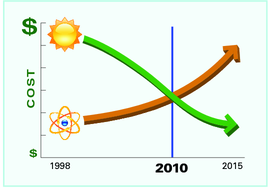 Solar power is beating fracked methane like the Internet won over BITNET.
Solar power is beating fracked methane like the Internet won over BITNET.
Solar and wind are cheaper than all fossil fuels now and for years have been cheaper than nuclear. As former FERC Chair Jon Wellinghoff says, by about 2023 solar power will overtake and pass every other source of power in the U.S. Solar power will win like the Internet did.
Solar Basics
- 2012-02-28: Economies of scale drive solar prices down, increasing deployment, which drives economies of scale…. Both models of panels (2005 and 2011) are around 15% efficiency, according to their specs. So it’s not efficiency that’s improved in commercial solar panels from 2005 to 2011: it’s price per watt.
- 2013-04-12: Electric utilities’ own think tank, Edison Electric Institute, warns them of “irreparable damages to revenues and growth prospects” if they don’t get on with solar power.
- 2014-03-05: According to Sabal Trail’s own figures, solar panels can generate just as much electricity on half the acreage of Sabal Trail’s fracked methane pipeline right of way, with no eminent domain, no drilling under rivers and through wetlands, and no risk to the Floridan Aquifer.
- 2015-05-12: The main solar issue for most people in Georgia is how to get financing. This was a special problem in Georgia because of the 1973 Georgia Territorial Electric Service Act. New Georgia solar law enables solar financing, leaving only four states, Florida among them, without third party power purchase agreements.
- 2015-07-15: Georgia is the fastest-growing U.S. solar market
- 2016-11-08: Tens of millions of fossil fuel money couldn’t stop the people of Florida from supporting solar power: Florida voters say no to misleading solar amendment
- 2017-01-01: Solar power now employs more people than coal, oil, and natural gas combined: U.S. Department of Energy’s second annual U.S. Energy and Employment Report; see also Computerworld, Forbes, and EcoWatch.
- 2017-02-18: New solar up 95% in 2016, more installed than gas or wind
- 2017-02-20: U.S. electric power source projections: solar still most by 2023
- 2015-07-14: By 2050 we can convert each and every U.S. state to sun, wind, and water power and nothing else. 100% renewable energy for U.S. by 2050
Chronology
The Solar category always has the latest posts. There are many more than the ones selected here to illustrate how fast solar is taking off, some local ways to use it for jobs, education, and clean air and water, and evidence for why solar will win.
 In 1894
nobody knew how to stop horse manure from increasing along with growing cities.
In 2013 we do know how to stop pollution and climate change from fossil fuels and nuclear:
power the world with sun, wind, and water.
In 1894
nobody knew how to stop horse manure from increasing along with growing cities.
In 2013 we do know how to stop pollution and climate change from fossil fuels and nuclear:
power the world with sun, wind, and water.
1931: “I’d put my money on the sun and solar energy. What a source of power! I hope we don’t have to wait until oil and coal run out before we tackle that.” —Thomas Edison
29 March 1973: Georgia Territorial Electric Service Act divides state into territories and prohibits electric generators from selling to any customer but the utility in their geographic territory. The Georgia Public Service Commission says:
Some retail competition has been present in Georgia since 1973 with the passage of the Georgia Territorial Electric Service Act. This Act enables customers with manufacturing or commercial loads of 900 kW or greater a one time choice in their electric supplier. It also provides eligible customers the opportunity to transfer from one electric supplier to another provided all parties agree.
Because of that law, you can’t you put up solar panels on your own land and sell your power to somebody somewhere else. And you can’t get a company like SolarCity or Lower Rates for Customers to put up solar panels on your property and sell you the power.
 5 December 2003,
Austin Energy changed from anti-solar to pro-solar in one year,
as reported by
Mike Clark-Madison for the Austin Chronicle 5 December 2003.
Austin was the fastest-growing city in the country year after year,
and needed new power.
Austin Energy considered nuclear, but had tried that in the 1980s:
way late, way over budget, huge political opposition.
It considered coal, but Austin is a clean energy city, so that would be
unfortunate.
Finally, it ran the numbers on solar, and discovered that for the same
amount of money buying into a coal plant would cost, it could give rebates
for rooftop solar and get as much power in the afternoon when the air conditioners
are running, distributed so it didn’t fail easily.
So Austin Energy went for solar power because of financial arithmetic,
and started offering a 75% rebate for rooftop home and business solar PV,
the most aggressive rebate in the country.
5 December 2003,
Austin Energy changed from anti-solar to pro-solar in one year,
as reported by
Mike Clark-Madison for the Austin Chronicle 5 December 2003.
Austin was the fastest-growing city in the country year after year,
and needed new power.
Austin Energy considered nuclear, but had tried that in the 1980s:
way late, way over budget, huge political opposition.
It considered coal, but Austin is a clean energy city, so that would be
unfortunate.
Finally, it ran the numbers on solar, and discovered that for the same
amount of money buying into a coal plant would cost, it could give rebates
for rooftop solar and get as much power in the afternoon when the air conditioners
are running, distributed so it didn’t fail easily.
So Austin Energy went for solar power because of financial arithmetic,
and started offering a 75% rebate for rooftop home and business solar PV,
the most aggressive rebate in the country.
8 August 2005: The same Energy Policy Act of 2005 that subsidized dirty oil and fracked methane including LNG exports also funded that oxymoron “clean” coal such as Southern Company’s Plant Ratcliffe in Mississippi, ethanol production lining the pockets of Monsanto, and the $8.3 billion loan guarantee to Georgia Power for the new nukes at Plant Vogtle. 2005 was a very long time ago in solar PV years….
29 November 2010: Matthew Croucher wrote in Arizona State University News that Georgia #3 state that could benefit most from solar electricity, behind only Arizona and Colorado, for use both in-state and for selling to other states.
2011-05-25: 2012 Southern Company Stockholder meeting
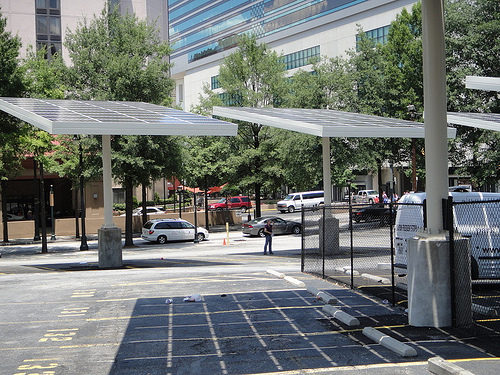 20 March 2012:
Solar parking lot in Atlanta,
20 March 2012:
Solar parking lot in Atlanta,
We don’t have to look to far Texas for examples of where to put solar panels. Let’s try Atlanta. Next to the downtown Marriott in Atlanta:
21 March 2012: Luckie Street Solar Project,
157 Luckie St NW, Atlanta, GA 30303
CATEGORY: Institutional Development
Developer: Turner Enterprises
Solar panels added to a surface parking lot that will produce nearly 200 kilowatt hours of energy, making this the largest solar project installed in Downtown Atlanta
$1 million
Completed 2011
29 March 2011: Opportunities from solar power —Jerome Tucker and MAGE SOLAR at LHS, 29 March 2011.
“And with this industry there’s opportunity for engineers, there’s opportunity for electricians, there’s opportunity for plumbers, truck drivers, across the board.”
24 June 2011: Energy as a National Security Challenge —Col. Dan Nolan @ Solar Summit,
Both are mostly unprotected.
- Petroleum for transportation (99% of oil used in this sector)
U.S. is world’s largest oil consumer 25% of world usage, 11 million barrels/day, 51% net imports, $1 billion/day imported oil, much of that money going to fuel foreign authoritarians and their militaries, plus spending on our military to defend it.- Electricity for homes, businesses, industry
Not a supply problem: an environmental problem, which can be replaced by renewables (solar, wind, tides). Also the brittle grid. Wouldn’t distributed generation be more secure?
1 April 2012: Anti-coal pro-solar insurgents win majority on Cobb EMC board.
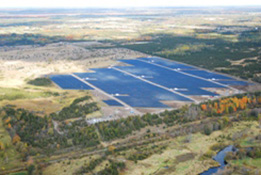 15 April 2012:
Private capital funding 100 acre 10 MW solar farm with customer Cobb EMC,
as reported by
Urvaksh Karkaria wrote for Atlanta Business Chronicle 12 April 2012.
15 April 2012:
Private capital funding 100 acre 10 MW solar farm with customer Cobb EMC,
as reported by
Urvaksh Karkaria wrote for Atlanta Business Chronicle 12 April 2012.
16 April 2012: “We’re just ripe for solar power,” said Chip Nelson, chief executive officer of Cobb EMC, as reported by Kristi E. Swartz in the AJC 16 April 2012. I summarized:
Coal is dead. Nuclear is going down. Solar will eat the lunch of utilities that don’t start generating it.
23 April 2012: Veterans for clean energy: Operation Free,
“In Iraq… the lines would stretch up to ten miles long under the hot sun, under constant risk of attack by extremists. I realized then just how vulnerable it makes any country to be dependent on oil, especially the United States, which uses nearly a quarter of the world’s supply.”
11 June 2012: Solar Lowndes High?
What does the world see driving north up I-75 past Valdosta? The empty roofs of Lowndes High School. Every south-facing one of which could hold solar panels.
 18 July 2012:
Moody’s confirms excellent bond rating for Lowndes County School District,
18 July 2012:
Moody’s confirms excellent bond rating for Lowndes County School District,
Lowndes Schools’ decrease of $4.1 million in annual bond payments after 2013 is more than the total $3.6 million in bonds Dublin Schools issued to pay for their megawatt of solar power. So Lowndes Schools could float bonds for solar panels at Lowndes High School like Dublin Schools did for Dubin High School. Or on the new Pine Grove Middle School, which already has some energy efficiency features. Either would decrease outgo in the future, thus evening up the financial structural balance and increasing reserve levels.
2 August 2012: Sierra Club reports on big fossil fuel’s coordinated attack on clean energy,
Sierra Club has dug up the money trail connecting fossil fuel companies funding with current legislative attempts to block renewable energy such as solar and wind. And there’s our old friend ALEC!
Super-lobbying group American Legislative Exchange Council (ALEC) promotes “our state legislators” for getting ALEC bills passed, including ones to oppose renewable energy.
 4 August 2012: ALEC responds to Sierra Club report,
and admits
ALEC opposes renewable energy portfolio (REP) standards, which was one of Sierra Club’s main points.
4 August 2012: ALEC responds to Sierra Club report,
and admits
ALEC opposes renewable energy portfolio (REP) standards, which was one of Sierra Club’s main points.
9 November 2012: John M. Broder wrote for NYTimes, Climate Change Report Outlines Perils for U.S. Military,
Climate change is accelerating, and it will place unparalleled strains on American military and intelligence agencies in coming years by causing ever more disruptive events around the globe, the nation’s top scientific research group said in a report issued Friday.
11 November 2012: Help the military stop climate change through sustainable renewable energy
24 November 2012: TV station gets it: Territoriality Law prevents solar in Georgia, about 20 November 2012 WSBTV.com, Georgia law keeps power customers from saving with solar energy.
6 December 2012: Financing solar energy: Georgia’s special problem.
16 December 2012: Renewables are Winning, Nukes are Dead, and Coal is Crashing, elaborating on an article by Kathleen Rogers and Danny Kennedy for EcoWatch 14 Dec 2012.
![]() 4 January 2013:
Carbon bubble? Solar and wind erode coal, gas, and biomass credit quality —Moody’s,
4 January 2013:
Carbon bubble? Solar and wind erode coal, gas, and biomass credit quality —Moody’s,
In Europe it’s already happening: solar and wind are causing bond-rater Moody’s to warn of downgrades of energy companies that depend on heat from burning coal, gas, or biomass. Moody’s earlier even warned the Bank of England of a potential carbon bubble developing. If combustion energy plants are affected like this, the credit effects will be even bigger on even-more-expensive nuclear plants, which Moody’s called a bet-the-farm risk way back in 2009.
 21 January 2013:
Rural AIDS: poverty the cause, solar power part of the solution,
because solar brings jobs and lower electric bills right to the rural
communities that need them most, where poverty is the root cause of AIDS
and multiple other ills. Big baseload nuclear, coal, gas, or oil plants
won’t do that, but distributed solar power will.
21 January 2013:
Rural AIDS: poverty the cause, solar power part of the solution,
because solar brings jobs and lower electric bills right to the rural
communities that need them most, where poverty is the root cause of AIDS
and multiple other ills. Big baseload nuclear, coal, gas, or oil plants
won’t do that, but distributed solar power will.
29 January 2013:
Power source growth rates like compound interest,
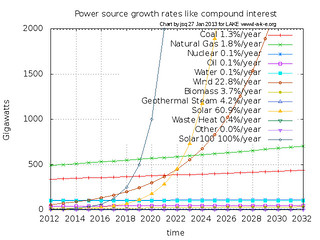 in which I used FERC’s own figures to predict that
solar power will overtake every other U.S. power source in actual deployed capacity within 9 years.
in which I used FERC’s own figures to predict that
solar power will overtake every other U.S. power source in actual deployed capacity within 9 years.
January 2013: Edison Electric Institute, the electric utilities’ own think tank, reported in Disruptive Challenges: Financial Implications and Strategic Responses to a Changing Retail Electric Business, that distributed solar power, producing most at utilities’ peak load times is already taking away their highest-priced product and is a disruptive challenge to the utilities’ cozy century-old baseload capacity model. Using research from Bloomberg New Energy Finance (BNEF), EEI spelled out that solar is growing like compound interest.
 11 March 2013: Videos: Solar Dublin High School groundbreaking @ DHS Solar 2013-03-11,
Georgia Power did not attend this groundbreaking for solar power to save Dublin High 40%, thus reducing teacher furloughs, financed by municipal bonds, made possible by cooperation among a wide range of government officials, private companies, and individuals: that was the groundbreaking story in Dublin, Laurens County, Georgia.
11 March 2013: Videos: Solar Dublin High School groundbreaking @ DHS Solar 2013-03-11,
Georgia Power did not attend this groundbreaking for solar power to save Dublin High 40%, thus reducing teacher furloughs, financed by municipal bonds, made possible by cooperation among a wide range of government officials, private companies, and individuals: that was the groundbreaking story in Dublin, Laurens County, Georgia.
10 April 2013: Fossil fuels get five times the subsidies of renewable solar and wind,
Fossil fuels get more than $70 billion dollars a year in U.S. government subsidies (tax breaks and direct spending), while solar and wind get only about $12 billion, so fossil fuels got more than five times as much, while nuclear got ten times as much (especially in Georgia). Even corn ethanol, that sounded-like-a-good-idea-at-the-time boondoggle, gets more subsidies than solar and wind put together.
3 May 2013: Solar Is Going To Change The World Much Faster Than Anyone Expects by Michael Sankowski for Business Insider, in which he said,
“…putting it into context will make your jaw drop with astonishment.
“My calculations show that if solar maintains 5 more years at current 23% rates per year price drops, solar power will be cheaper than using existing coal plants. That’s right — it will be cheaper to build new solar plants than to use existing coal plants. It sounds absolutely crazy.”
Actually, his numbers were too low.
16 May 2013: Goldman Sachs invested in 100 MW of SolarCity financing.
 22 May 2013: at Southern Company’s Stockholder Meeting,
SO CEO Tom Fanning
announced a tiger team to come up with a business model for
distributed solar and wind energy.
He said it would report back that same summer.
We’re still waiting.
22 May 2013: at Southern Company’s Stockholder Meeting,
SO CEO Tom Fanning
announced a tiger team to come up with a business model for
distributed solar and wind energy.
He said it would report back that same summer.
We’re still waiting.
24 May 2013: AP reported Standard & Poor’s lowered Southern Company’s rating from stable to negative, due to unrecovered cost overruns on Kemper Coal in Mississippi, potential for the same at nuclear Plant Vogtle in Georgia, and implicitly because of lack of enough shift to renewable solar and wind power.
18 June 2013: Videos of GA PSC on Georgia Power coal plant closings @ GA PSC 2013-06-18,
 21 June 2013:
Ask Georgia Power to conserve our water –Garry Gentry for WWALS @ GA PSC 2013-06-18,
21 June 2013:
Ask Georgia Power to conserve our water –Garry Gentry for WWALS @ GA PSC 2013-06-18,
There is no need to use our Floridan Aquifer water to build more baseload power plants while Georgia lags behind Michigan, Massachusetts, and even tiny New Jersey and Maryland in solar power.
WWALS calls on the PSC to ask Georgia Power to conserve our water and to bring jobs to south Georgia through solar power and wind off the Georgia coast.
29 June 2013: The cloudy day doesn’t last for an entire month —John S. Quarterman,
The disruptive challenge electric utilities face is like telephone companies faced years ago, as Edison Electric Institute recently pointed out. Circuit switching 20 years ago is like distributed solar power and the smart grid it needs now; this is what I described at the Georgia Public Service Commission meeting Tuesday 18 June 2013.
3 July 2013: two analysts downgraded Southern Company because of its money-losing “clean coal” operation in Mississippi and its Plant Vogtle nuclear boondoggle in Georgia, and explicitly because of SO’s lack of emphasis on renewable energy.
 11 July 2013:
More solar by Georgia Power –GA PSC
525 megawatts more solar power required, on top of last year’s
210 megawatts, for more than 735 MW total. That’s still trailing New
Jersey’s already-installed 1,000 MW, but it’s a big step forward.
11 July 2013:
More solar by Georgia Power –GA PSC
525 megawatts more solar power required, on top of last year’s
210 megawatts, for more than 735 MW total. That’s still trailing New
Jersey’s already-installed 1,000 MW, but it’s a big step forward.
21 August 2013:
“Solar is growing so fast it is going to overtake everything,”
said FERC Chair Jon Wellinghof as reported by
Herman K. Trabish for Green Tech Media 21 August 2013.
“If a single drop of water on the pitcher’s mound at Dodger Stadium is doubled every minute, a person chained to the highest seat would be in danger of drowning in an hour.
Indeed, as GTM Research’s MJ Shiao recently pointed out, in the
next 2 1/2 years the U.S. will double its entire cumulative capacity
of distributed solar — repeating in the span of a few short
years what it originally took four decades to deploy.
“Geothermal, wind, and other resources will supplement solar,
Wellinghoff said. “But at its present growth rate, solar will
overtake wind in about ten years. It is going to be the dominant
player. Everybody’s roof is out there.”
31 October 2013:
Citizens for solar power; GA leg. not so much, about a series of open houses organized by Georgia Sierra Club and allies which revealed much citizen support for solar, although the Georgia General Assembly mostly has not yet come around.
15 November 2013: Sabal Trail Transmission submitted to the
Federal Energy Regulatory Commission (FERC) an incredibly
misleading set of incorrect assertions about solar power in its
Draft Resource Report 10: Alternatives (RR10), claiming solar power would require more land than a 500-mile methane pipeline, even though Sabal Trail’s own acreage numbers
refute that claim, and that RR10 never mentions that most solar power
goes on rooftops or on already-cleared land, not requiring bulldozing
forests, wetlands, or drilling under rivers and roads.
26 November 2013:
More solar jobs already than coal, or oil and gas extraction,
9 December 2013:
ALEC solar tax. The super-lobbying group American Legislative Exchange fights back against the simple economics of ever-plunging solar power prices:
22 December 2013: Liam Denning wrote for the Wall Street Journal,
Lights Flicker for Utilities,
3 January 2014:
Solar benefits outweigh costs in NC, about what
John Downey wrote for Charlotte Business Journal 23 October 2013, Study: Solar benefits outweigh costs in NC.
30 January 2014:
South Georgia Farmers Workshop on Solar Power in Nashville, GA.
In March 2014: former U.S. DoE Secretary Steven Chu
advocated utility financing, installation, and maintenance of rooftop solar,
and idea SO CEO Fanning had broached in May 2013.
3 March 2014: Solar financing bill HB874 dies in Georgia House Energy Committee.
According to Sabal Trail’s own numbers, twice as much land for the entire three-pipeline Spectra -> Sabal -> FSC proposed gouge through three states as would be required to produce as much solar power.
14 March 2014:
Paul Gilding wrote on his blog,
Carbon Crash Solar Dawn.
15 March 2014:
100% sun, wind, and water can power each U.S. state and the world –Stanford study.
22 April 2014:
As predicted U.S. solar capacity grew more than 400% in 4 years,
according to
U.S. Energy Information Administration (eia): 12,057 megaWatts in February 2014 / 2,326 megaWatts in 2010 = 5.18 times, which is more than 2 * 2 = 4, ergo former FERC Chair Jon Wellinghoff was right.
13 May 2014: Simon Solar Farm ribbon cutting in Social Circle, Georgia
“Clean, reliable, cost effective, peak demand energy for $8 cents
per kWh for the next 50+ years (“ALL IN”)! No negative
health or environmental externalities! No fuel cost ever! No State
or rate payer incentives required in GA. Permanent downward pressure
on GA electric rates. Clean, cost effective, reliable renewable
energy = Priceless!!”
28 May 2014: Slight changes at Southern Company @ SO 2014-05-28,
18 June 2014: Thousands of solar jobs a thousand miles north of here: SolarCity buys Silevo
20 June 2014:
56% increase shale gas 2012-2040; 100% increase solar 2012-2014
Meanwhile, as we’ve already seen,
U.S. solar power production already increased more than 400% in four years,
and there’s every reason to believe that kind of solar growth will continue
for another decade.
This is why in less than a decade, as former FERC Chair Jon Wellinghoff predicted,
solar will overtake every other U.S. power source.
20 June 2014:
20 MW Solar at Hazlehurst, GA by Silicon Ranch for Green Power EMC
Under an agreement with owner-operator Silicon Ranch Corporation, Green Power EMC will receive all the energy produced by the solar project over a 25-year period. Construction is scheduled to begin this year, and the facility will be ready to produce electricity in late 2015.
23 July 2014: 10 MW solar power at Robins Air Force Base.
14 August 2014: Fourth solar military project by Georgia Power: Kings Bay Submarine Base.
29 September 2014:
NYC Schools to use more solar power; how about in sunny southeast?
11 October 2014: China can go 80% sun, wind, water power by 2050 —WWF
19 November 2014,
Even more U.S. solar jobs than in coal or oil and gas extraction
Meanwhile, ldquo;production and nonsupervisory employees” in the oil and gas extraction industry increased 4% from 106,400 in September 2013 to 110,600 in September 2014, according to Oil and Gas Extraction: NAICS 211 by the U.S. Bureau of Labor Statistics. Total oil and gas industry employment increased 8% from 197,500 to 213,100 in the same period.
Of course, we really should be using the 2013 (not 2014) oil and gas figures to compare to the Solar Jobs Census 2013, so those 142,000 solar jobs would be 33% more than the 106,400 nonmanagerial oil and gas extraction jobs, and 72% of the total 197,500 oil and gas jobs. But oil and gas jobs are growing so slowly it doesn’t really matter which year: they might as well be standing still while solar jobs soar upwards.
And the solar employment picture just keeps getting more sunny….
2015-04-15:
(Before the) Southern Company Annual Stockholder Meeting @ SO 2015-05-27
2015-05-26: Shareholders demand Southern Company stop supporting climate change denial.
2016-05-25: Southern Company Annual Stockholder meeting.
2017-05-24: Video: “Solar panels, heck yeah!” CEO Tom Fanning at SO Stockholder meeting.
 “That’s what is happening in solar. It could double every two
years.”
“That’s what is happening in solar. It could double every two
years.”
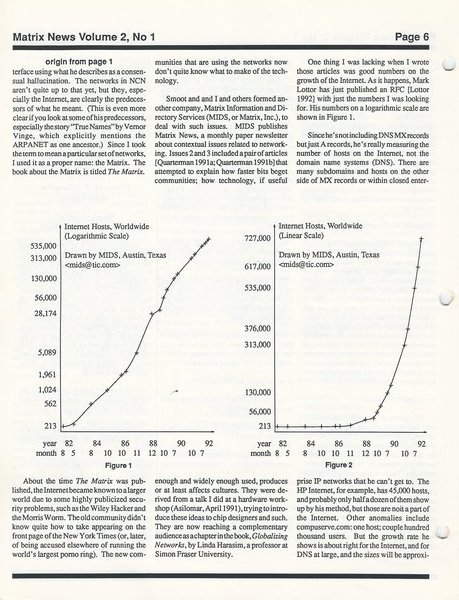 25 August 2013:
Solar will win like the Internet did,
because its deployment is growing like compound interest,
and for some of the same reasons.
25 August 2013:
Solar will win like the Internet did,
because its deployment is growing like compound interest,
and for some of the same reasons.
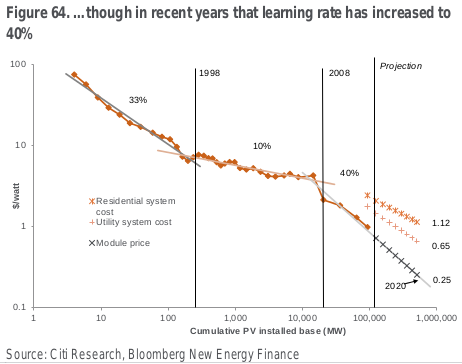 In October 2013: Citi GPS in
Energy Darwinism: The Evolution of the Energy Industry, pointed out that
solar learns way faster than any other energy source.
In October 2013: Citi GPS in
Energy Darwinism: The Evolution of the Energy Industry, pointed out that
solar learns way faster than any other energy source.
 That 119,000 jobs in the solar industry is also more than the 106,400 “production and nonsupervisory employees” in the oil and gas extraction industry, and gaining rapidly on the total of 197,500 for that industry in September 2013, according to Oil and Gas Extraction: NAICS 211″, U.S. Bureau of Labor Statistics.
That 119,000 jobs in the solar industry is also more than the 106,400 “production and nonsupervisory employees” in the oil and gas extraction industry, and gaining rapidly on the total of 197,500 for that industry in September 2013, according to Oil and Gas Extraction: NAICS 211″, U.S. Bureau of Labor Statistics.
 5 December 2013:
Solar Oakland Schools expect 45% savings,
5 December 2013:
Solar Oakland Schools expect 45% savings,
“Our contract with SunPower will enable Oakland Unified School District to maximize our use of clean renewable energy, dramatically reduce utility expenses, and use the savings to enhance academic programs,” said OUSD Superintendent Dr. Gary Yee. “We will also have the opportunity to take advantage of linked learning initiatives such as the successful SunPower Solar Academy, which integrates real world work experience with rigorous academic programs to inspire students while preparing them for college and careers.”
Arizona, Virginia, and now they’re trying in Georgia: ALEC wants to tax your solar panels. ALEC is trying to legislate buggy whip requirements in an age of affordable electric cars.
 suddenly there is talk on Wall Street of a looming “death spiral” for the business, with solar power being the culprit.
suddenly there is talk on Wall Street of a looming “death spiral” for the business, with solar power being the culprit.
 5 March 2014: Twice the acreage than solar for Sabal Trail pipeline to produce the same power @ FERC 2014-03-05
5 March 2014: Twice the acreage than solar for Sabal Trail pipeline to produce the same power @ FERC 2014-03-05
26 March 2014:
Time to call it: Carbon Crash, Solar Dawn,
Another observer gets it that
green solar power is winning.
Letting a fracking deliver company turn us into “stakeholders” in a white
elephant methane pipeline would be an even huger waste after the
pipeline stopped being used in a decade or so because
sun, wind, and water power everything by then,
winning like the Internet did.

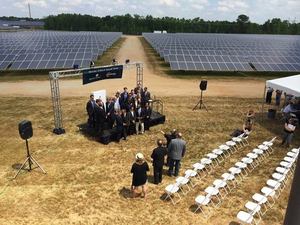 Bryan writes: “You are looking at $8M in annual guaranteed cash
flow-20 year PPA w/ GA Power. Who says there isn’t a pot of gold
under the rainbow? The GA Power Advanced Solar Initiative (ASI) is
Simon Solar (25X)! $1.7B in Georgia Economic Development, 50,000
tons of steel, 3M Solar Panels, 25,000 jobs++. Solar charging the GA
Economy. These conservative clean energy initiatives have taken
Georgia from 38th in the Country to #5 in solar energy development
in the US.”
Bryan writes: “You are looking at $8M in annual guaranteed cash
flow-20 year PPA w/ GA Power. Who says there isn’t a pot of gold
under the rainbow? The GA Power Advanced Solar Initiative (ASI) is
Simon Solar (25X)! $1.7B in Georgia Economic Development, 50,000
tons of steel, 3M Solar Panels, 25,000 jobs++. Solar charging the GA
Economy. These conservative clean energy initiatives have taken
Georgia from 38th in the Country to #5 in solar energy development
in the US.”
 27 May 2014:
More American jobs in the solar industry than in coal mining. –True, says PolitiFact
27 May 2014:
More American jobs in the solar industry than in coal mining. –True, says PolitiFact
 Solar car charging station at the Southern Company Stockholder Meeting: that’s new. Other solar changes were detectable, if you knew what to look for, and with hints from SO CEO Tom Fanning and new R&D VP Larry Monroe here are some,
Solar car charging station at the Southern Company Stockholder Meeting: that’s new. Other solar changes were detectable, if you knew what to look for, and with hints from SO CEO Tom Fanning and new R&D VP Larry Monroe here are some,
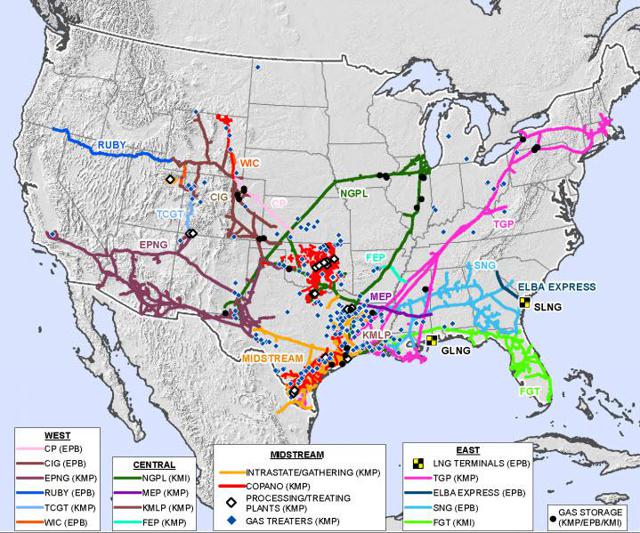 He’s real excited about this phenomenal fracked methane growth story, to profit a few fossil fuel companies by taking local Americans’ land for LNG export.
He’s real excited about this phenomenal fracked methane growth story, to profit a few fossil fuel companies by taking local Americans’ land for LNG export.
![]() The ground-mounted solar project will be constructed near Hazlehurst, Ga., in Jeff Davis County. It will be one of the largest solar generating facilities in Georgia. The solar array will occupy approximately 135 acres and will incorporate over 87,000 solar modules. Once completed, the solar array will generate more than 43,000 megawatt hours of clean, renewable electricity annually.
The ground-mounted solar project will be constructed near Hazlehurst, Ga., in Jeff Davis County. It will be one of the largest solar generating facilities in Georgia. The solar array will occupy approximately 135 acres and will incorporate over 87,000 solar modules. Once completed, the solar array will generate more than 43,000 megawatt hours of clean, renewable electricity annually.
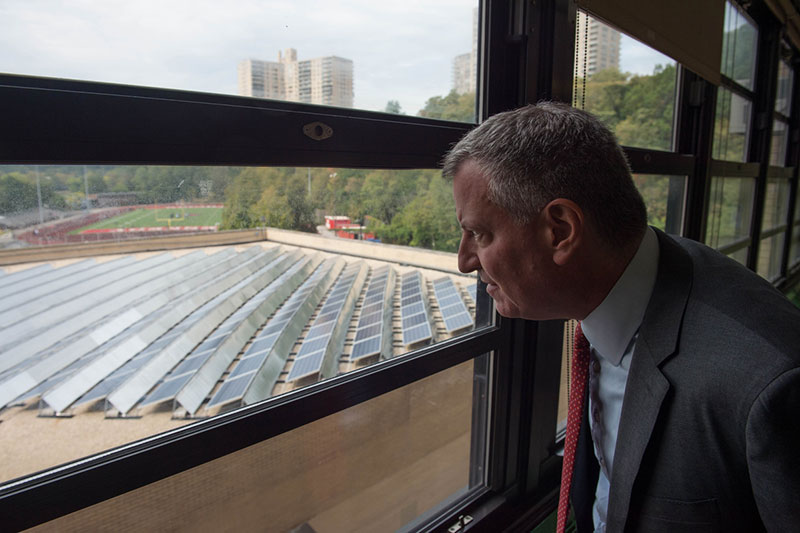 Solar high schools: not just for Dublin, Georgia anymore.  New York City, and Rochester, NY, too! How about solar Lowndes High School? Or the new Valdosta High School? Or since Valdosta has already put solar at its Mud Creek Wastewater Treatment Plant, how about on other city buildings? How about on the county palace? Or in Hahira, Dasher, Remerton, or Lake Park?
Solar high schools: not just for Dublin, Georgia anymore.  New York City, and Rochester, NY, too! How about solar Lowndes High School? Or the new Valdosta High School? Or since Valdosta has already put solar at its Mud Creek Wastewater Treatment Plant, how about on other city buildings? How about on the county palace? Or in Hahira, Dasher, Remerton, or Lake Park?
 If the most populous country in the world can do it, even the Sunshine State and the rest of the world can do it. With no new nuclear, depending heavily on on energy efficiency and conservation, using China’s huge number of rooftops for solar power, with almost as much wind power, plus a bit more hydropower, China can go 80% renewable energy by 2050. While reducing energy use per capita and increasing GDP per capita. So this path will not only improve Chinese quality of life by getting rid of massive pollution by reducing emissions 90% from otherwise-projected levels; it will also give Chinese citizens more money in their pockets. China has no more sunshine than the U.S. or much of Canada does, so there’s no reason the Canada, U.S., and pretty much every country can’t do this, too.
If the most populous country in the world can do it, even the Sunshine State and the rest of the world can do it. With no new nuclear, depending heavily on on energy efficiency and conservation, using China’s huge number of rooftops for solar power, with almost as much wind power, plus a bit more hydropower, China can go 80% renewable energy by 2050. While reducing energy use per capita and increasing GDP per capita. So this path will not only improve Chinese quality of life by getting rid of massive pollution by reducing emissions 90% from otherwise-projected levels; it will also give Chinese citizens more money in their pockets. China has no more sunshine than the U.S. or much of Canada does, so there’s no reason the Canada, U.S., and pretty much every country can’t do this, too.
 In a year solar jobs increased more than 20% to 142,000, according to the National Solar Jobs Census 2013….
In a year solar jobs increased more than 20% to 142,000, according to the National Solar Jobs Census 2013….
 Solar power is rising on Georgia, the southeast, the U.S., and the world,
and all the fossil fuel and nuclear companies
and all their electric utilities,
cannot stop that sun from coming up.
Solar power is rising on Georgia, the southeast, the U.S., and the world,
and all the fossil fuel and nuclear companies
and all their electric utilities,
cannot stop that sun from coming up.


Pingback: Stanford beats Harvard; divests from coal | On the LAKE front
Pingback: Climate Rally and EPA hearings Tuesday and Wednesday in Atlanta | SpectraBusters
Pingback: Is the Sabal Trail pipeline necessary? –Lori McCraney | SpectraBusters
Pingback: An unnecessary threat by an unsafe company –Ted Turner’s Nonami Plantation to FERC about Sabal Trail | SpectraBusters
Pingback: Petition GA Gov. Deal to oppose Sabal Trail pipeline - WWALS Watershed Coalition
Pingback: Is Porter Ranch the natural gas industry’s Three Mile Island? | On the LAKE front
Pingback: Radioactive tritium leak at Indian Point nuke stopped, but still in groundwater | On the LAKE front
I installed solar panels at my residence in Jackson, GA in November of 2015. We consumed 4500 kWh in March 2015. Our March 2016, post-solar, was 700 kWh. Our 25-year internal rate of return after incentives for installing solar was 8%. Solar is not only good for the environment, but it’s also a practical and viable investment.
Pingback: GA Gov. Nathan Deal signs solar financing law | On the LAKE front